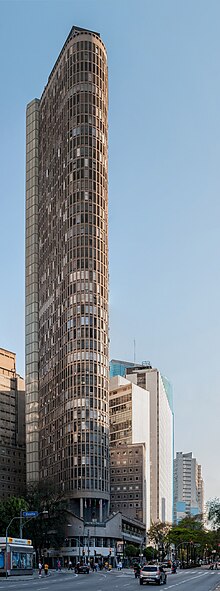Franz Heep
Adolf Franz Heep (born July 24, 1902 in Fachbach an der Lahn , † March 4, 1978 in Paris ) was a Brazilian-French architect of German origin. Heep was a supporter of modernism and was strongly influenced by the Bauhaus style.
Life
Heep was born in the Lahn valley and studied architecture at the art school in Frankfurt am Main , where he met Adolf Meyer and was his assistant until his death in 1929. In the early 1930s he moved to Paris where he worked for Le Corbusier . In 1932 he founded an architectural office together with the Polish architect Jean Ginsberg (1905–1983), where he designed apartment blocks and successfully adapted Corbusier's design principles. These include the buildings on Avenue de Versailles (1933), Vion-Whitcomb Avenue (1934) and Rue des Paturo (1935). For his father, the main teacher Johannes Heep, he designed a residential building in 1933, which was completed in 1934 in Eschhofen near Limburg (Lahn). Due to massive changes inside and outside, the house lost its monument status during a renovation (1988).
After the Second World War he emigrated to Brazil in 1947 , where he settled in São Paulo . There he initially worked for an engineering and construction office and founded his own architectural office in 1950. In 1952 he was naturalized and in 1959 he was officially recognized as an architect. Heep had a favorable environment in São Paulo as the city showed a penchant for foreign architects. So he was able to realize most of his buildings there. The best known is the Edifício Itália , which at 168 meters is still the second- tallest skyscraper in São Paulo and the third-tallest building in Brazil.
He worked from 1958 and 1965 as a professor at the School of Architecture and Urbanism of the Universidade Presbiteriana Mackenzie. He was then a member of the United Nations Architecture Council for Latin American countries on projects in Peru and Paraguay.
Works (selection)
- 1949: Edifício Tinguá
- 1953: Edifício Ibaté
- 1953: Edifício Maracanã
- 1953: Edifício Normandie
- 1953: Edifício Icaraí
- 1953: Conjunto dos Dominicanos
- 1954: Novotel Jaraguá
- 1955: Edifício Araraúnas
- 1956: Edifício Iporanga
- 1958: Edifício Lausanne
- 1959: Edifício Arlinda
- 1965: Edifício Itália
literature
- Jean-Paul Midant, Juan Calatrava, José Luís López Jiménez: Diccionario Akal de la arquitectura del siglo XX. Tres Cantos, Madrid 2004, ISBN 84-460-1747-4 , p. 392.
- Marcelo Barbosa: A obra de Adolf Franz Heep no Brasil. 2002. At the same time dissertation FAU-USP.
Web links
- Biography and list of works by Franz Heeps (English)
- Reception for Franz Heep's work (Portuguese)
- Marcelo Barbosa: Do public ao privado. A habitação coletiva na obra de Franz Heep. In: arcoweb.com.br Projeto Design, issue 272 (Portuguese)
Individual evidence
- ^ Biography of Franz Heeps
- ↑ Cultural monuments in Hesse, City of Limburg, published by the State Office for Monument Preservation Hesse
| personal data | |
|---|---|
| SURNAME | Heep, Franz |
| ALTERNATIVE NAMES | Heep, Adolf Franz (full name) |
| BRIEF DESCRIPTION | Brazilian-French architect of German origin |
| DATE OF BIRTH | July 24, 1902 |
| PLACE OF BIRTH | Fachbach on the Lahn |
| DATE OF DEATH | March 4th 1978 |
| Place of death | Paris |

